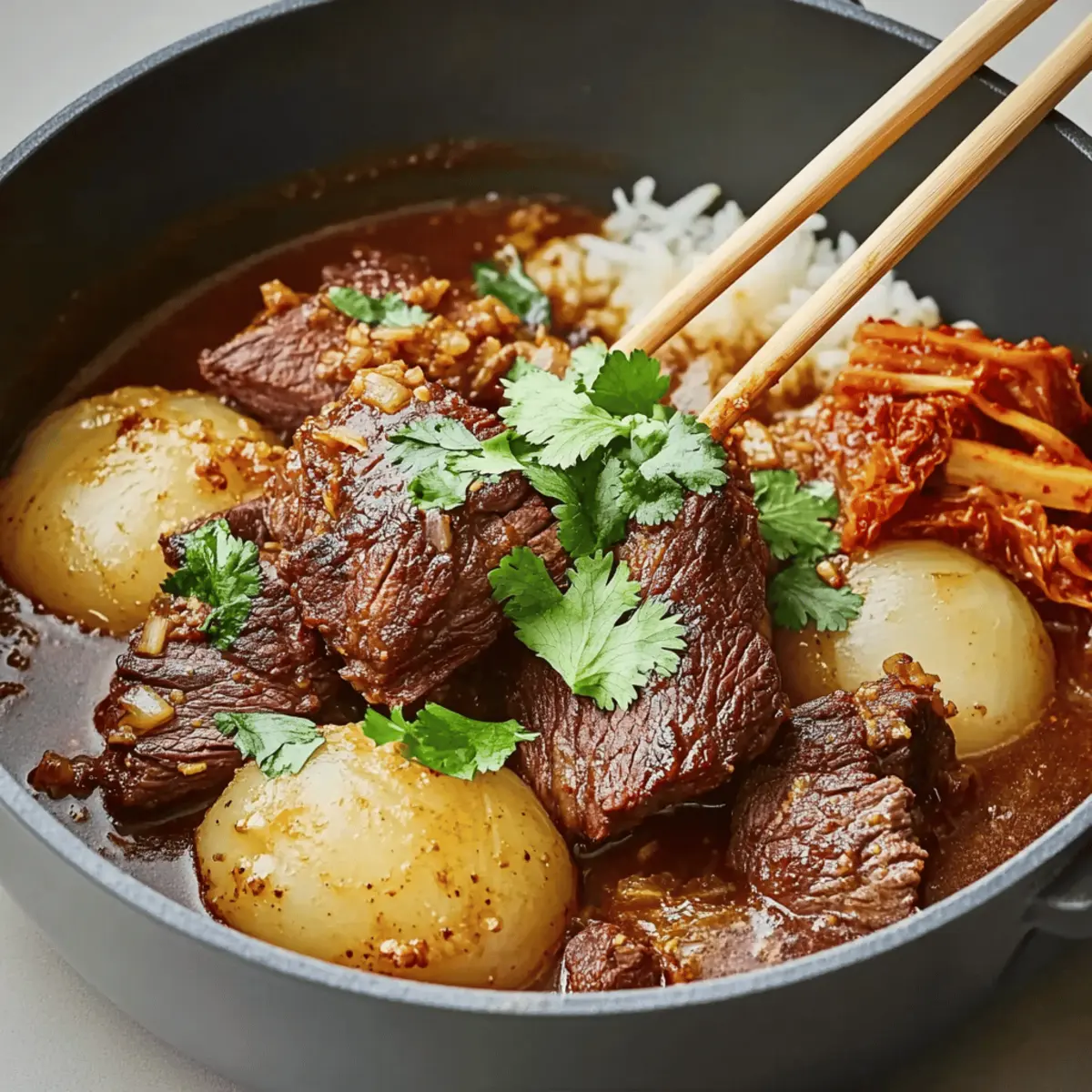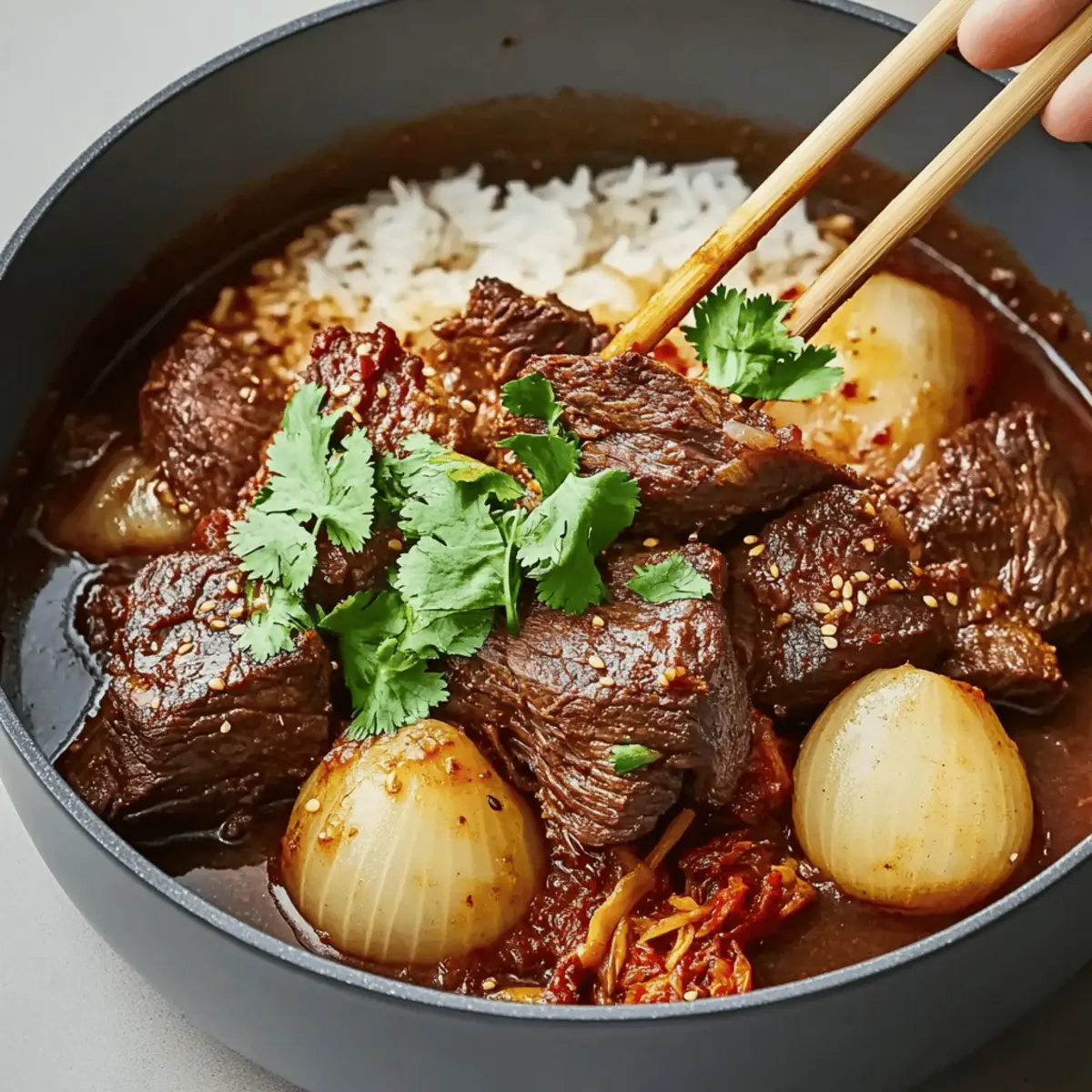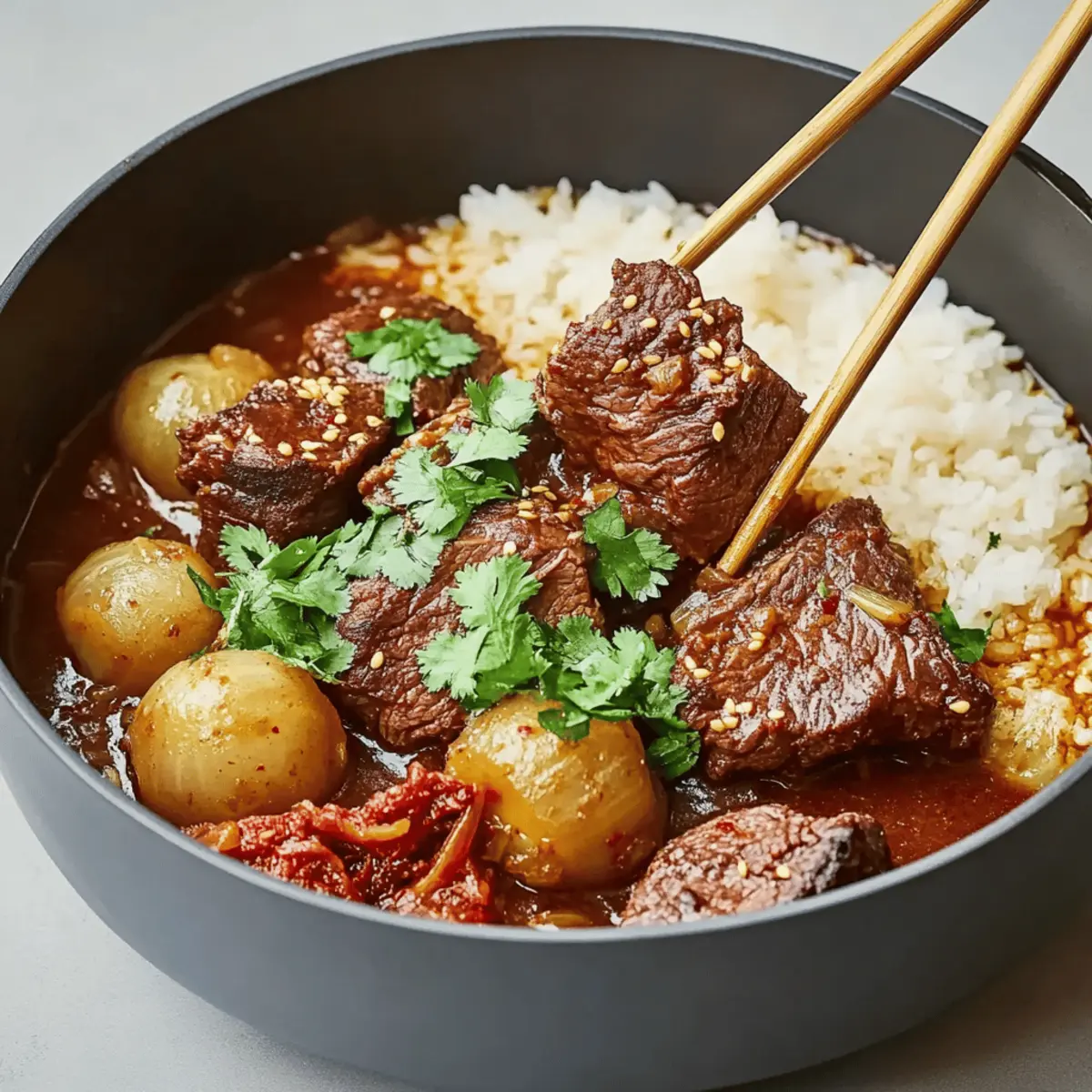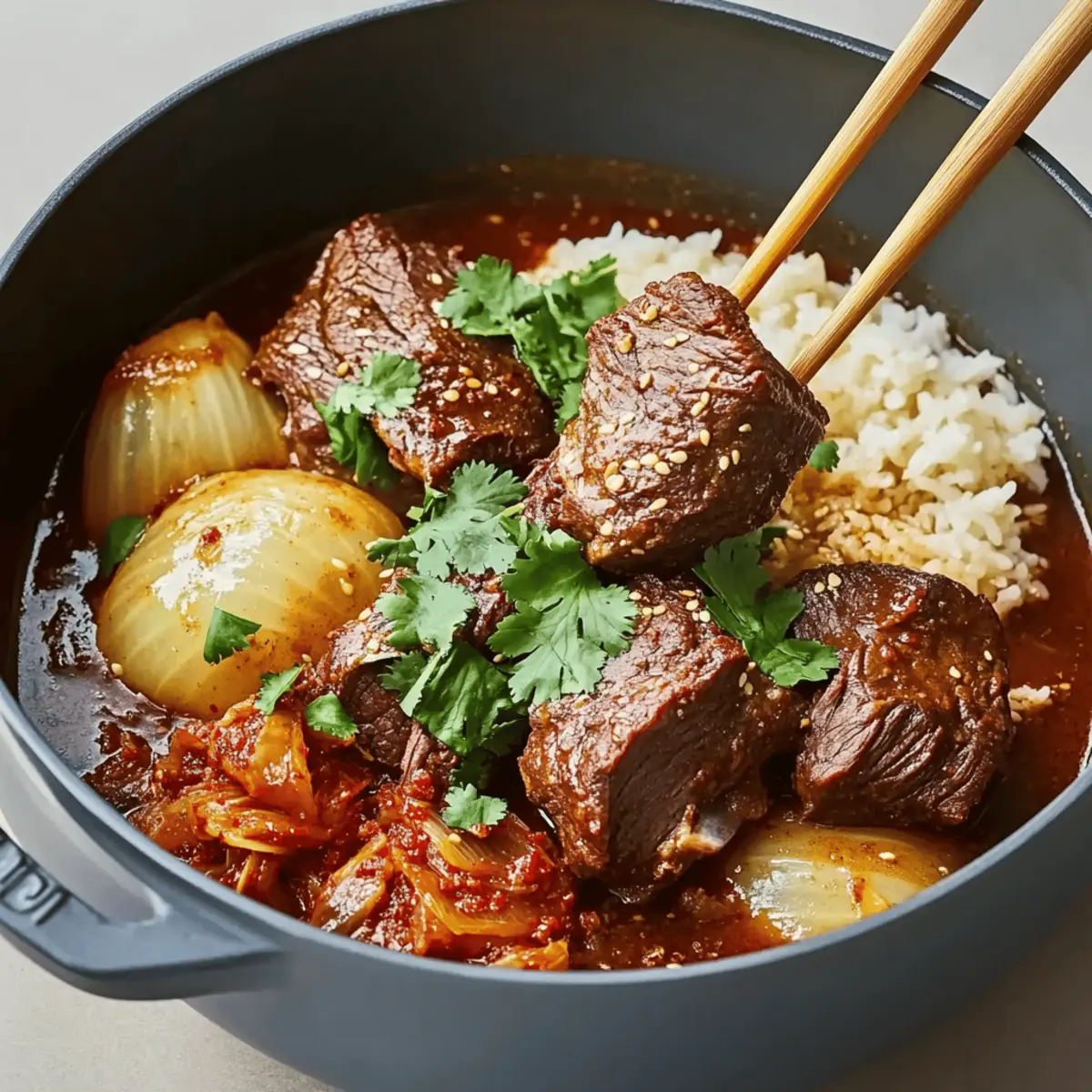As I stirred the pot, the aroma of ginger and garlic wafted through my kitchen, instantly transporting me to the bustling streets of Seoul. This Korean Style Pot Roast is not your ordinary comfort food; it’s a delightful fusion of rich tradition and bold flavors that warms the heart and soul. In just a little time, you’ll create a savory masterpiece by infusing tender beef with the unique spices that define Korean cuisine. The best part? This dish is not only perfect for family dinners but also makes for effortless meal prep, allowing you to savor every bite throughout the week. Curious about how to prepare this mouthwatering dish that’s sure to impress? Let’s dive in!

Why Make Korean Style Pot Roast?
Hearty, Bold Flavors: This dish is a celebration of savory Korean spices paired beautifully with tender beef.
Comforting Fusion: Korean Style Pot Roast combines the beloved essence of traditional pot roast with the excitement of Korean cuisine.
Versatile Serving Options: Delight in serving it over rice, or pair with delightful sides like Herbed Potato Rolls for a complete meal.
Meal Prep Friendly: Make a big batch, and enjoy it throughout the week—flavors only get better with time!
Crowd-Pleasing Delight: Whether hosting a family gathering or a cozy dinner, this dish is bound to impress and satisfy everyone at the table.
Unique Twist on Tradition: Elevate your pot roast game by incorporating bold elements of Korean cooking, taking your comfort food experience to new heights!
Korean Style Pot Roast Ingredients
For the Beef
- Beef Chuck Roast – The primary protein; provides rich flavor and tenderness. Consider using brisket or short ribs for different taste profiles.
For the Seasoning
- Kosher Salt – Enhances flavor and tenderizes the meat.
- Vegetable Oil – Used for browning the beef; substitute with olive oil if desired.
- Sweet Onion – Adds sweetness and depth of flavor; substitute with yellow or red onion.
- Garlic Cloves – Introduces a robust aromatic flavor; can use garlic powder as a substitute (1/8 tsp per clove).
- Fresh Ginger – Contributes warmth and a hint of spice; ground ginger can be used if fresh is not available.
- Gochujang – A fermented chili paste that adds depth and heat; alternatives include a mix of chili sauce and miso for a similar profile.
- Brown Sugar – Balances the spiciness; substitute with honey or maple syrup if needed.
- Soy Sauce – Provides umami and saltiness; low-sodium soy sauce works if watching salt intake.
For the Cooking Liquid
- Beef Broth – Creates a savory cooking liquid; vegetable broth can be used for a lighter flavor.
For Serving
- Cooked Rice – Serves as a base that absorbs the pot roast’s flavors.
- Fresh Cilantro – Adds a bright, fresh note; can be omitted or replaced with green onions.
- Kimchi – Offers a tangy, spicy contrast to the richness of the pot roast; optional for those seeking a milder option.
Step‑by‑Step Instructions for Korean Style Pot Roast
Step 1: Preheat the Oven
Begin by preheating your oven to 300°F (150°C). This low temperature will ensure that your Korean Style Pot Roast cooks slowly, allowing the beef to become tender and flavorful. While the oven is heating up, prepare the other ingredients to keep the process smooth and efficient.
Step 2: Brown the Beef
In a large Dutch oven, heat 2 tablespoons of vegetable oil over medium-high heat. Season the beef chuck roast generously with kosher salt, then place it in the hot oil, searing until golden brown on all sides, about 3–4 minutes per side. This step is crucial as it enhances the flavor of your pot roast with a beautiful caramelized crust.
Step 3: Cook Aromatics
Once the beef is browned, remove it from the pot and set it aside. In the same Dutch oven, add one finely chopped sweet onion and sauté for about 2–3 minutes until translucent. Stir in 4 minced garlic cloves and 1 tablespoon of grated fresh ginger, cooking for another minute until fragrant. The aromatic base is essential for a savory Korean Style Pot Roast.
Step 4: Mix Sauces
In a separate bowl, combine 2 tablespoons of gochujang, 2 tablespoons of brown sugar, ¼ cup of soy sauce, and 2 cups of beef broth. Mix well until smooth, then pour this flavorful sauce over the aromatics in the Dutch oven. Stir to combine, allowing the rich sauce to meld with the onions, garlic, and ginger.
Step 5: Braise the Beef
Return the browned beef chuck roast to the pot, spooning some sauce over the top. Cover the Dutch oven with its lid and transfer it to the preheated oven. Let it braise for about 3–4 hours, or until the meat becomes fork-tender and pulls away easily. Check periodically to ensure there’s enough liquid in the pot.
Step 6: Serve and Garnish
Once your Korean Style Pot Roast is ready, carefully transfer the beef to a cutting board and let it rest briefly before slicing. Serve it over bowls of cooked rice, allowing the savory sauce to soak into the grains. Garnish with chopped fresh cilantro and a side of kimchi to enhance this comforting dish with bright flavors.

Make Ahead Options
Korean Style Pot Roast is an excellent choice for meal prep, allowing you to savor its delicious flavors without the last-minute rush. You can brown the beef and cook the aromatics up to 24 hours in advance, then refrigerate them in an airtight container. Additionally, the entire pot roast can be assembled (including sauces) and refrigerated for up to 3 days before cooking. To maintain quality, keep the sauce separate from the beef until just before braising to prevent the meat from becoming too salty. When you’re ready to enjoy your pot roast, simply transfer everything to the Dutch oven and braise as directed, bringing the comforting warmth of Korean flavors to your table with minimal effort!
Expert Tips for Korean Style Pot Roast
-
Choose Quality Meat: Select cuts with good marbling for a juicy pot roast; chuck roast works best for flavor and tenderness.
-
Adjust Gochujang: Taste your sauce before adding it to the roast; feel free to increase or decrease gochujang to suit your spice preference.
-
Braising Basics: If using a slow cooker instead, after browning the meat, cook on low for 6-8 hours—perfect for meal prep with excellent results.
-
Enhanced Flavor: Consider marinating the beef overnight in the soy sauce and spices for deeper flavor penetration, making your Korean Style Pot Roast even more special.
-
Stir Occasionally: During braising, check occasionally to ensure there’s enough liquid; adding more beef broth if needed keeps your pot roast moist and prevents burning.
-
Serving Suggestions: Enjoy with traditional banchan like pickled radishes and seasoned vegetables to complete your meal and surprise your guests!
Storage Tips for Korean Style Pot Roast
-
Fridge: Store leftover Korean Style Pot Roast in an airtight container for up to 3 days. Make sure to reheat gently on the stove or in the microwave until warmed through.
-
Freezer: For longer storage, freeze the pot roast in a freezer-safe container for up to 3 months. Thaw overnight in the fridge before reheating to retain flavor and texture.
-
Reheating: When reheating, add a splash of beef broth if the sauce has thickened to ensure it remains moist and flavorful. Aim for an internal temperature of 165°F (74°C) for safe consumption.
What to Serve with Korean Style Pot Roast?
Imagine the flavor-packed essence of your Korean Style Pot Roast, complemented perfectly by a stunning array of sides that ignite your taste buds.
- Steamed White Rice: It’s the classic pairing that soaks up the savory sauce, creating the perfect, hearty foundation for every delicious bite.
- Garlic Mashed Potatoes: Creamy and velvety, they add a rich, comforting texture that pairs wonderfully with the tender meat.
- Spicy Kimchi: This fermented side offers a tangy crunch and a kick of spice, perfectly cutting through the dish’s savory richness. Don’t skip on this; the contrast creates a symphony of flavors in your mouth.
- Sesame Spinach Salad: A light, crisp salad drizzled with sesame oil and seeds adds freshness and balance to the meal, keeping it vibrant and inviting.
- Banchan (Korean Side Dishes): Try seasoned cucumber or pickled radishes for a traditional touch that complements the flavors in the pot roast beautifully.
- Asian Slaw: Crunchy cabbage and vibrant veggies tossed in a citrus dressing add a refreshing contrast to the warm, savory dish.
- Spicy Szechuan Noodles: These can be a delightful twist to the meal; their chewy texture and warm spice work harmoniously with the pot roast.
- Fruit-Infused Iced Tea: Cool and refreshing, it offers a sweet note that balances the richness of the pot roast and enhances your dining experience.
Korean Style Pot Roast Variations
Feel free to get creative and customize your Korean Style Pot Roast with these delightful twists!
- Vegetarian Delight: Replace beef with tofu or tempeh to create a hearty, plant-based version that’s just as satisfying.
- Flavorful Additions: Toss in carrots, potatoes, or mushrooms for a veggie boost and added texture; they will soak up all the savory goodness!
- Heat It Up: If you love spice, increase the amount of gochujang or toss in fresh chili peppers for an extra kick that’ll set your taste buds dancing.
- Sweet Twist: For a different depth of flavor, consider using maple syrup in place of brown sugar; it adds a lovely complexity to the sweetness.
- Soy-Free Option: If you’re avoiding soy, try coconut aminos as a substitute for soy sauce; it maintains that savory component while being gluten-free.
- Beefy Alternatives: Experiment with pork shoulder or lamb for a unique flavor profile; each will give a delicious twist to this classic dish. Imagining the rich aroma of pork braising? Yum!
- Crispy Topping: For a delightful crunch, top your pot roast with crispy fried onions just before serving; it’s a tasty way to add texture.
- Comforting Sides: Serve with traditional banchan like seasoned spinach or Kimchi for added authenticity, enhancing your meal with vibrant flavors.
Explore these variations, and don’t hesitate to add your personal touch for a truly unique experience!

Korean Style Pot Roast Recipe FAQs
How do I choose the right cut of beef for Korean Style Pot Roast?
Absolutely! For the best results, I recommend using beef chuck roast because its marbling keeps the meat juicy and tender during slow cooking. However, if you’re looking for a different flavor profile, brisket or short ribs can also work well. Just make sure to select cuts with good marbling for that melt-in-your-mouth texture!
What is the best way to store leftover Korean Style Pot Roast?
Very simple! Store your leftover Korean Style Pot Roast in an airtight container in the refrigerator for up to 3 days. Make sure to let it cool completely before sealing. For longer storage, freeze it in a freezer-safe container for up to 3 months. Just remember to thaw it overnight in the fridge before reheating to maintain that delicious flavor!
Can I freeze Korean Style Pot Roast after cooking?
Absolutely! To freeze, allow the pot roast to cool down completely, then slice or keep it whole, as you prefer. Place it in a freezer-safe container or vacuum-seal it to prevent freezer burn. It’ll stay fresh for up to 3 months! To reheat, thaw overnight in the refrigerator, and gently warm it on the stove, adding a splash of beef broth for moisture.
What if my pot roast isn’t tender after cooking?
If your pot roast isn’t fork-tender, it might need more time in the oven. I recommend covering it with a lid and braising it for an additional 30 minutes to an hour, checking occasionally. Cooking at a lower temperature will also help; try setting your oven to 250°F (120°C) as a gentler alternative for slow cooking. Just be patient, and you’ll be rewarded with that melt-in-your-mouth goodness!
Is this recipe suitable for people with dietary restrictions?
Certainly! The Korean Style Pot Roast can be easily adapted for dietary needs. If you’re concerned about gluten, simply use tamari instead of soy sauce. For a vegetarian version, substitute the beef with tofu or tempeh and use vegetable broth. Always check labels for any allergies, especially with gochujang, as some brands may contain wheat.
How long should I let the pot roast rest before serving?
I often let the pot roast rest for about 10-15 minutes after removing it from the oven. This resting period allows the juices to redistribute throughout the meat, resulting in a juicier slice. A little patience goes a long way here, and trust me, it’ll be worth the wait!

Korean Style Pot Roast: Savory Comfort in Every Bite
Ingredients
Equipment
Method
- Preheat your oven to 300°F (150°C).
- In a large Dutch oven, heat vegetable oil over medium-high heat. Season the beef with kosher salt, then sear until golden brown, about 3–4 minutes per side.
- Remove the beef and sauté the chopped onion for 2–3 minutes. Stir in minced garlic and grated ginger, cooking for another minute.
- Combine gochujang, brown sugar, soy sauce, and beef broth in a bowl. Pour over the aromatics and stir.
- Return the beef to the pot and cover. Braise in the oven for 3–4 hours, or until fork-tender.
- Slice the beef and serve over cooked rice, garnishing with cilantro and a side of kimchi.

Leave a Reply